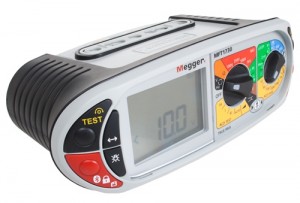In May last year, we reported how the Electrical Safety Council (ESC) was pushing for harsher penalties on companies who do not reinforce electrical product recall policies. After carrying out research into recalled products the ESC found that typically only 10-20 percent of recalled electrical goods are actually ever returned.
The Megger MFT1730 Multifunction Tester offers downloading of 18th Edition test results
This means that 80 percent of these potentially dangerous products are still probably used in homes which means there is a change of these faulty goods causing fires or electrocution to those using them.
Despite a multiplicity of tests that manufacturers have to perform on electrical products before they can go on sale, there are always some with defects that slip through the net. Last month in January 2014 for example, both B&Q and Aqualisa issued product recalls. Firstly, a B&Q manufacturing supplier identified a component defect that could lead to a risk of reduced electrical insulation on its three-pin USB power adapters purchased between August and October 2013.
Secondly, Aqualisa identified a potential fault in some of its electric showers that could result in a leak at the base of the showering unit, as a result of routine product testing and quality control processes.
“Once a product has left the manufacturer, these two types of problems are worlds apart when it comes to testing and traceability, reveals Barry Atkins, managing director of PASS Ltd, the independent test equipment expert.
“The first product is a portable appliance while the second is a fixed appliance which is, or should be, bought only by professional electricians. The first case is addressed by PAT testing while the second is addressed by the 18th Edition Wiring Regulations.
PAT testing only applies to the workplace whereas 18th Edition testing of fixed appliances applies in all cases during installation and subsequent inspections.
Testing is not just about hooking up instruments. In the specific case of a shower, a visual inspection comes first on all terminations to check that screw connections are tight. Only then is insulation resistance checked between line and earth and between neutral and earth, followed by the earth continuity test, and finally the RCD test.
The electrical industry is constantly evolving, with innovation coming from every turn, as well as the rules and regulations governing electrical installation and testing. It is of vital importance to learn about these changes and use high quality, safe electrical test equipment that is in compliance with all rules and regulations.
As always, the choice is between discrete testers for specific groups of 18th Edition tests or multifunction testers. Larger project teams may prefer to have one contractor performing insulation resistance while another performs earth continuity testing on another circuit, in which case discrete instruments may be favoured.



